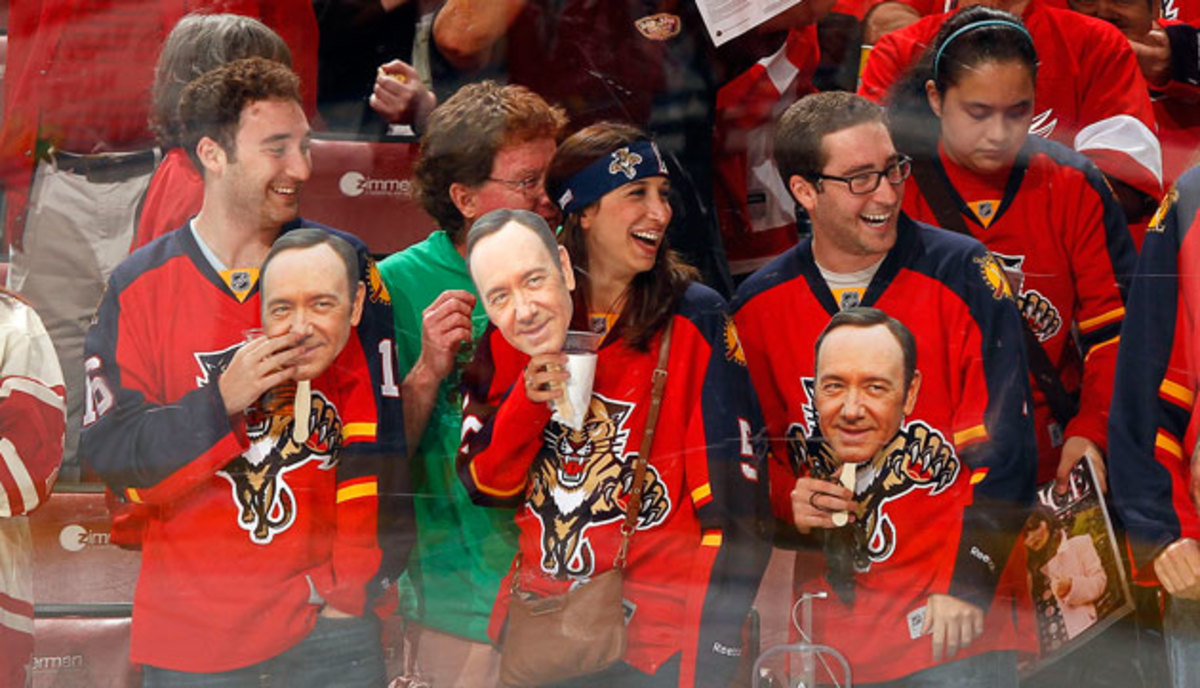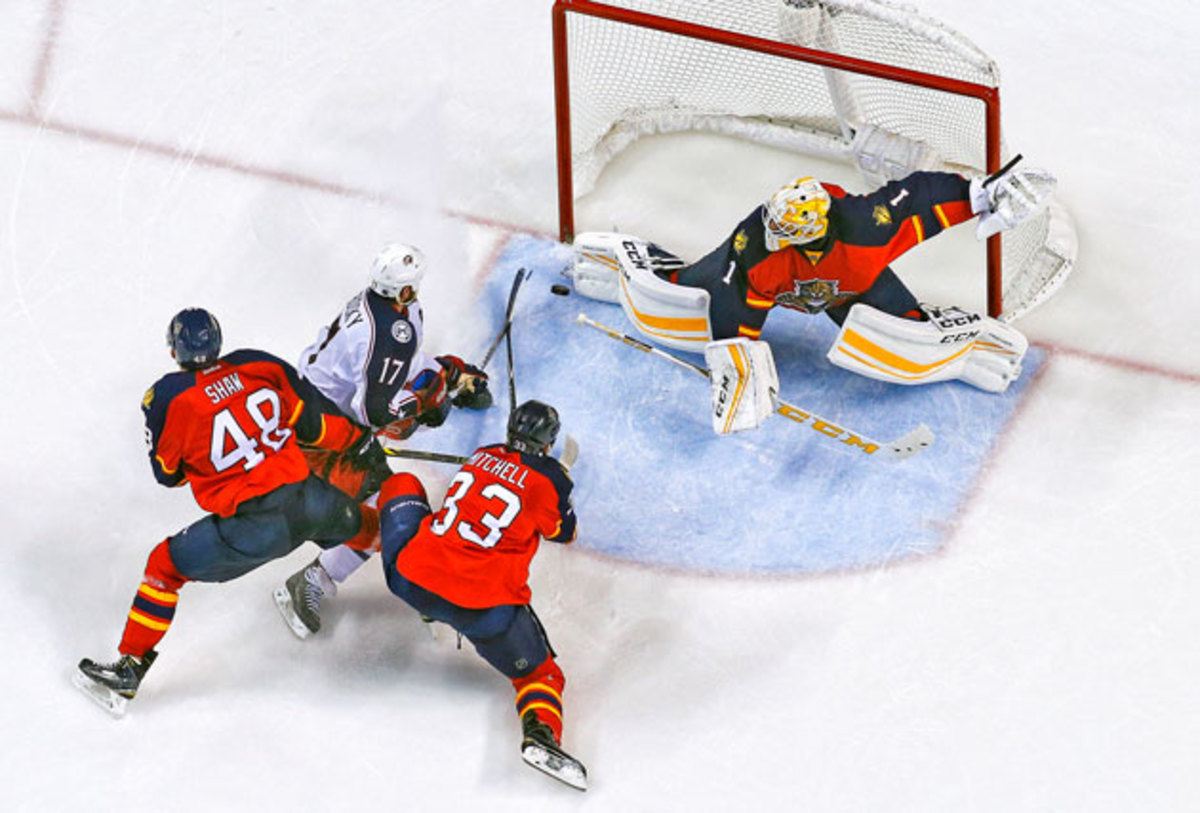WTFlorida?! The Panthers are weird, wacky—and winning

This story appeared in the April 11, 2016 edition of SPORTS ILLUSTRATED. To subscribe, click here.
The zaniest show in hockey begins anew after each Panthers win, once the dressing room doors close, Fetty Wap fades from the speakers and Holographic Astronaut President Frank Underwood enters on a coat hanger.
To be clear, there are plenty of oddities framing—or maybe fueling—Florida’s surprising rise to the top of the Atlantic Division. Defenseman Aaron Ekblad, the reigning NHL rookie of the year and the league’s second-youngest blueliner at 20, distracts teammates during warmup soccer by hee-hawing like a donkey. Winger Jaromir Jagr, the league’s oldest player at 44 and the active career leading scorer in every offensive category, hangs a fake mullet at his locker to match the real one flowing from his dome. Goaltender Roberto Luongo professes a great passion for poop jokes. “If there was a ranking [of eccentricity], we’d be up there,” forward Vincent Trocheck says. “We do a lot of weird stuff as a team.”
But no higher honor exists for the Panthers than their screwball cousin of hard hats and championship belts, postgame awards bestowed in the dressing rooms of more, well, normal clubs. Here, the treasured prize for the player of the game is a blue hoodie, adult size XL, with purple streaks of star clusters across the chest serving as the backdrop for the translucent, disembodied, floating head of actor Kevin Spacey.
Few know what the sweatshirt symbolizes to the team or how it came to exist. Those who do refuse to say. Rumor has veteran forward Shawn Thornton discovering it on a mid-December road trip to New York, right before Florida won a franchise-record 12 straight games. But, “you’re not going to get any information out of me on that sweatshirt,” he says. “I love the mystery of it.”
As the Panthers head toward just their second postseason in 15 years, in search of their first series win since 1996, such curiosity has only tightened their bond with the Oscar-winning Spacey. Before he visited the BB&T Center on March 19, his camp and the Panthers decided to create 10,000 paper Spacey Facey masks to conceal the actor’s presence in the stands. The big reveal came during the second period against Detroit, when the video board showed Spacey, in the lower bowl, taking off his mask while wearing the sweatshirt. The announced crowd of 20,817 that night was the largest in team history. “Probably the loudest it’s been all year, when he came up on the big screen,” Trocheck says.
Spacey in Space. Only slightly stranger than Florida in First.

Bizarreness has a history of latching onto success in Sunrise, Fla. Exactly 20 years ago, in the franchise’s third season of existence, the Panthers’ run to the Stanley Cup Final was punctuated by fans hurling rubber rats onto the ice after goals, an homage to the real one forward Scott Mellanby struck dead in the locker room before scoring twice in the 1995–96 home opener. “It took on a life of its own,” says Mellanby, now an assistant general manager for Montreal. “It became a story, and it was our story.”
This current chapter begins with the 65-year-old, white-haired GM, whose ringtone is set to the Pharrell Williams’s hit, “Happy.” And can you blame him?
Hired in May 2010 to perform what Panthers exec Bill Torrey calls “this total redo,” Dale Tallon followed the same path he had in assembling the ’10 Stanley Cup champion Blackhawks, who were led by then 22-year-old Jonathan Toews and 21-year-old Patrick Kane. “I only know one way,” he says. “Draft properly. Get a depth chart. Be strong up the middle. That’s what we tried to do in Chicago, and that’s what we’re trying to do in Florida.”
Why you should hop on the Florida Panthers bandwagon
This season former first-round picks Jonathan Huberdeau, Erik Gudbranson and Nick Bjugstad each average more than 15 minutes per game. Trocheck, picked 64th overall in 2011, and Reilly Smith, plucked from Boston last summer, have combined for 49 goals. Favorable bounces at consecutive draft lotteries brought Aleksander Barkov, the second pick in ’13 who is the team leader with 0.89 points per game this season, and the hee-hawing Ekblad, No. 1 overall in ’14 and someone whom Capitals coach Barry Trotz already proclaims “has Hall of Fame written all over him.” Under coach Gerard Gallant, the Panthers run a disciplined defensive system that allows 2.45 goals per game, seventh fewest in the NHL and the best mark in club history.
But, “if you’re going to go young, like we have, you better have the right guys in that locker room to show them the way,” Tallon says. To insulate his young assets, he sought Stanley Cup winners like Jagr (Pittsburgh, 1991 and ’92), Thornton (Anaheim, 2007; Boston, ’11), defenseman Brian Campbell (Chicago, ’10) and captain Willie Mitchell (Los Angeles, ’12, ’14).
There is, however, one veteran Panther still chasing his first ring. Luongo claims the disappointment of losing (as a Canuck) in the 2011 Stanley Cup Final will haunt him forever. “I was so close and fell short,” the 37-year-old goalie says. “I can only imagine what it feels like to be on the other side.”
"People realized it was no longer the same old Panthers," Tallon says.
In many ways, when Luongo waived his no-trade clause to leave Vancouver in March 2014, it felt like coming home. He had played in Florida for five seasons during his 20s, met his future wife at a pizza shop near the practice facility and always summered in South Florida, close to the in-laws. But everything he remembered about the franchise was different. “There was nobody left who was here when I was,” he says. With the second-worst record in the East, the Panthers were then headed for another early summer. Still, Tallon’s pitch convinced him this was a positive change worth trusting.
“I wasn’t just going to come back to a situation where the team is developing players then getting rid of them when their time is up to renew,” Luongo says. “I wanted to come to a place where the talent was there, and it was going to be surrounded with the right pieces to make a run in the next few years.”
The Panthers demonstrated their commitment to him, and to their rebuilding plan, by assuming most of Luongo’s massive contract, which even he once admitted “sucks.” The team’s finances had stabilized under new owner Vinnie Viola, who bought the team in 2013; accepting eight remaining years at $5.33 million annually for an aging goalie showed that the franchise could dine at the adult table. “People realized it was no longer the same old Panthers,” Tallon says. “We were ready to send a message that we were committed to winning.”
The SI Extra Newsletter Get the best of Sports Illustrated delivered right to your inbox
Subscribe
The change reinvigorated Luongo too. With a 2.38 goals-against average, .921 save percentage and 33 wins, he is enjoying his best season since he was a Vezina Trophy finalist in 2010–11.
Freed from the Canadian media’s unceasing glare, Luongo has also embraced a more publicly outgoing side since the trade. He runs fantasy football leagues with fans, convinced Jagr to regrow his trademark mullet and maintains one of the NHL’s most entertaining Twitter accounts. Sample post from @Strombone1: “Just picked up a little something for ya @68Jagr for the 3-on-3 tomorrow. Hope you wear it.” Attached was a photo of a Life Alert emergency response necklace. Another, too off-color for this magazine, was punctuated: #JagrBomb.
Speaking of which. . . .

After a 3–2 victory over Arizona on Feb. 25, Jagr bequeathed Spacey in Space to Barkov—born four years after the Mulleted One hoisted his first Cup—for his two-goal night that included the game-winner. Jagr lingered at his stall and began packing for an upcoming road trip. By assisting on Barkov’s second goal, he became the NHL’s oldest player to record a 44-point season and moved within four points of third on the all-time list. Within two weeks he would breeze past Gordie Howe.
At this particular moment Jagr, 44 years and 10 days old, endeavors to explain perhaps the biggest secret in Sunrise—how he has managed what he has. From summoning strength coach Tommy Powers for postmidnight workouts to wearing a weighted vest during practice, Jagr’s unconventional training methods have always been his calling card, never more visible now that he leads Florida with 62 points. But equally vital, Jagr says, are spiritual practices rooted in the Indian religious concept of chakra.
“I’m not saying completely, but you can slow down [aging] 50% for sure,” he says. “Everything’s information and energy. If you change the information on how you’re getting old, you don’t get old. That’s why I’m playing hockey. I want to prove it’s the right way. You cannot just talk about it. You have to show them, Hey, I did it. This is working.”
Translated from Sanskrit, chakra means “wheel.” Traditional eastern belief holds that seven major chakras, housed up and down the spine, regulate energy flow throughout the body. When they are balanced and uninhibited by negative energy, the body performs best. Jagr says he has explored this concept for at least the past 17 years, or roughly two-thirds of his 1,625-game career.
Aaron Ekblad is Panthers’ man-child monster on the blue line
“It’s your body getting energy,” he says. “Maybe when you’re young you’ve got so much energy because you’re young, all you need is from sleep or food. But when you get older you need it from somewhere else. When you open up your chakras, the positive energy comes to you. So if you’re working out two hours every day on your body, you better make sure you’re spending three hours on your soul.”
Says Powers, “He’s got so many aspects to him that make him successful. He’s not just going in there and doing 100 squats.”
Chances are teammates would follow him even if he were. Barkov, for instance, now wears weighted vests and ankle weights in practice. Bjugstad started swinging a hockey stick hooked into a cable system and whacks medicine balls like pucks. After practices, when Jagr leads his disciples in skating or puckhandling drills, the scene resembles a mama duck and her ducklings. “I just do what he tells me to do,” Gudbranson says. “And it works.”
Though none of the young Panthers have specifically inquired about Jagr’s spiritual pursuits, Gudbranson’s general attitude explains how the age gap has been bridged. Ekblad spent his rookie season learning from both Campbell, his partner on the top defensive pairing, and Mitchell, his landlord. Jussi Jokinen, the team’s assists leader, regularly saddles up to linemates Trocheck and Smith during intermissions with a whiteboard to talk tweaks. Says Trocheck, “There’s one or two older guys for every line or partnership helping ease us into the whole professional hockey thing.”
So while the rest of the league sees strange sweatshirts and odd team antics, there is a strong foundation being built underneath, one they hope will last long after the Year of Spacey ends. “It’s not going to fall away,” Gallant says. “There are too many good players. We can afford to pay money. Everyone wants to be here right now. It’s not like in the past.”
Which is to say the franchise feels legitimized. Attendance has risen 35% over last season, by far the NHL’s largest increase, and an $86 million public-aid package from Broward County will help operate and upgrade the BB&T Center. Heck, the league’s lowest-valued franchise, at $186 million according to Forbes, in the lowest-rated television market received free advertisement when Spacey appeared on NBC’s Today show, and the hosts held up the hoodie.
To quote Jagr, as he packed the mullet wig into his bag: “A lot of s--- is going on. It’s fun.”
#JagrBomb
